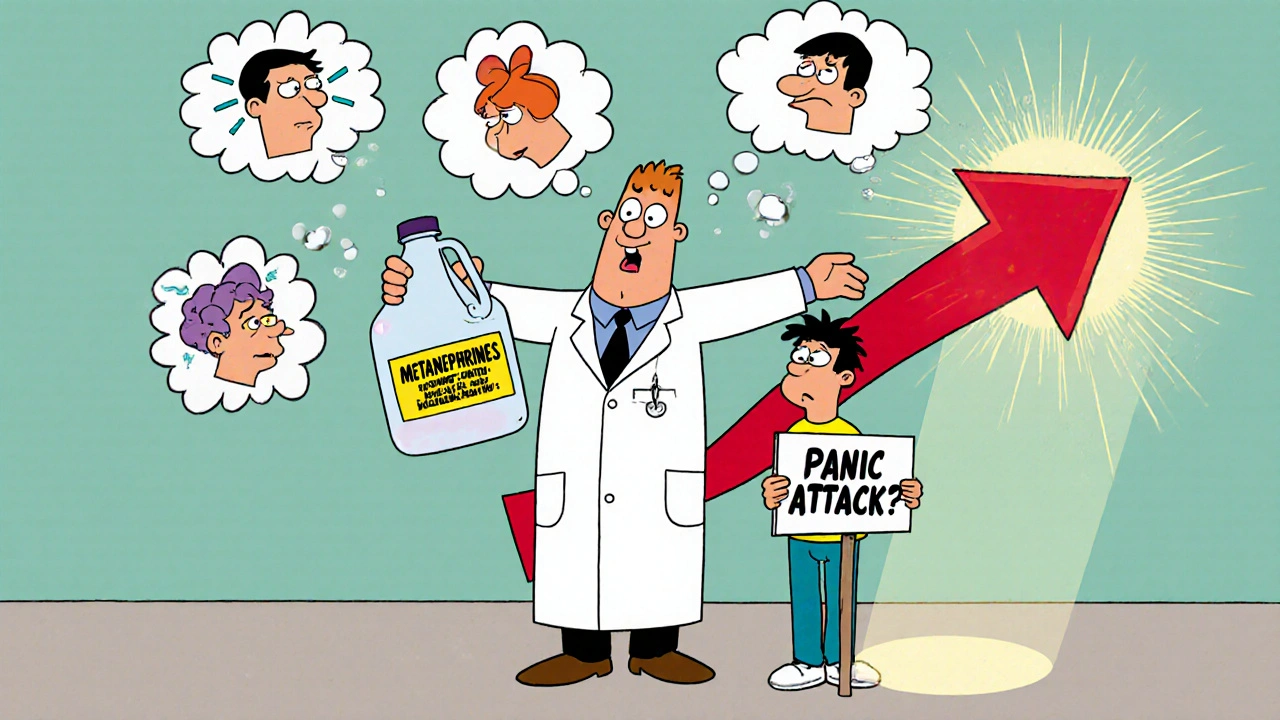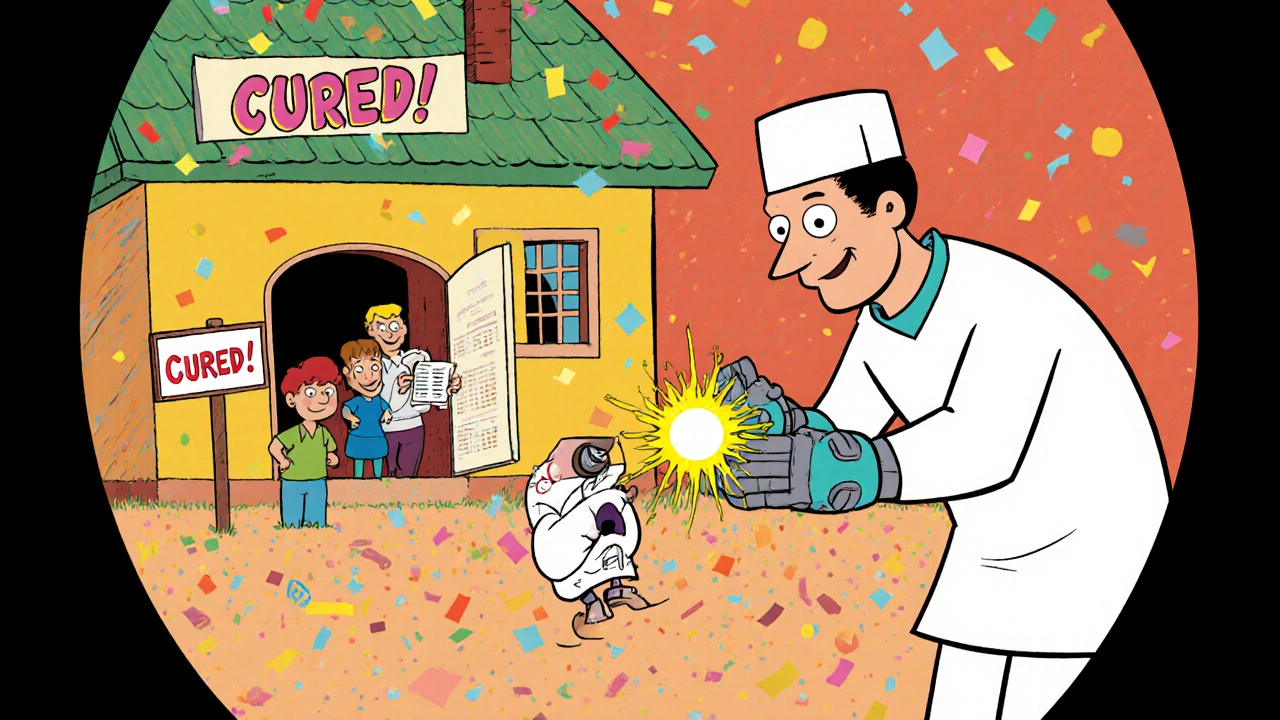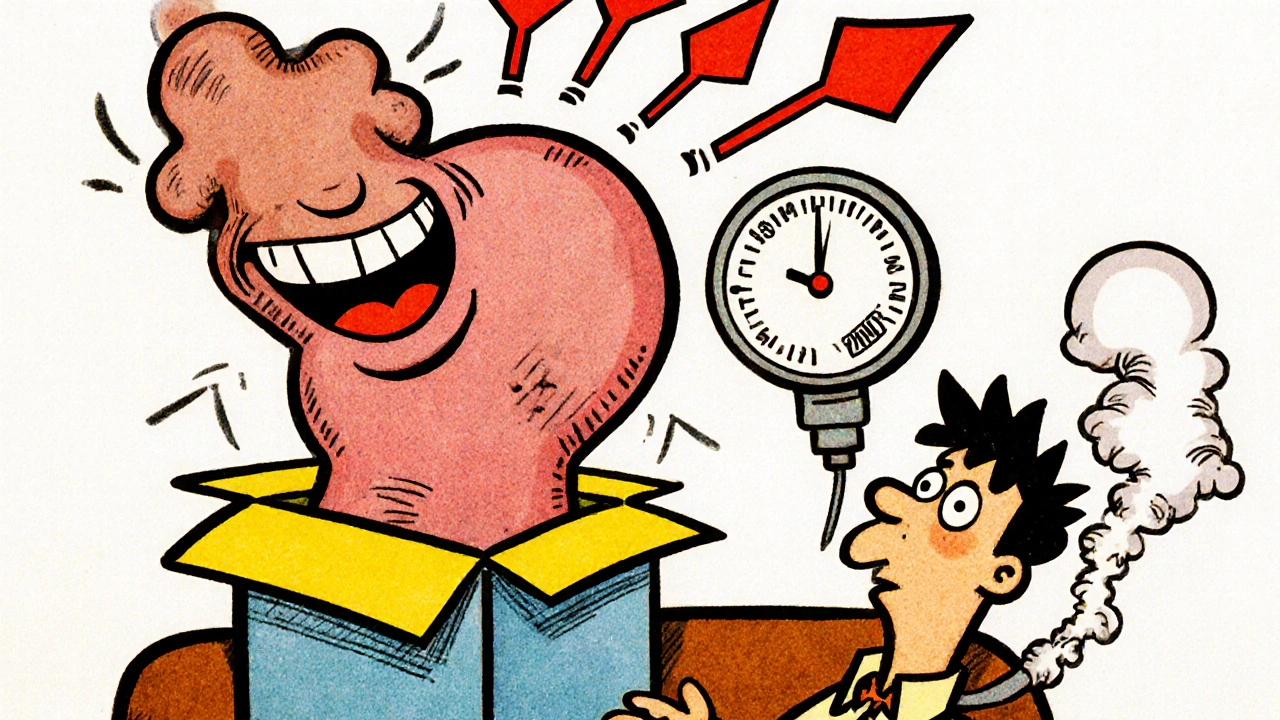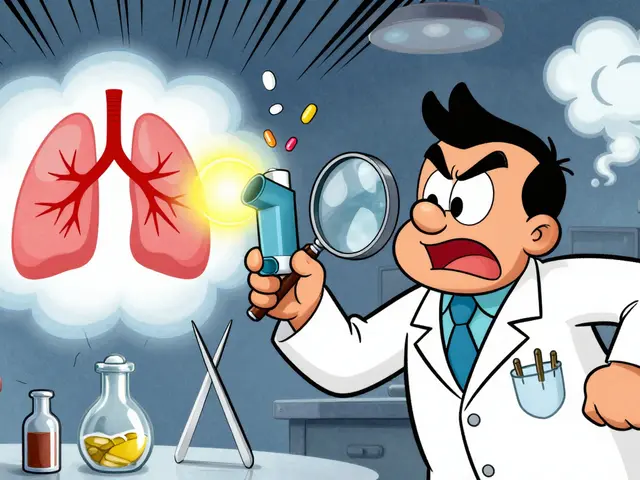What Is a Pheochromocytoma?
A pheochromocytoma is a rare tumor that grows in the adrenal glands-small organs sitting on top of each kidney. It doesn’t look like typical cancer, but it’s dangerous because it pumps out too much adrenaline and noradrenaline. These are the same hormones your body releases when you’re scared or running for your life. But with this tumor, they flood your system even when you’re just sitting down watching TV.
It’s not common. Only about 1 in 200 people with high blood pressure have it. But when you do have it, your body acts like it’s under constant attack. You might get sudden, crushing headaches, drenching sweats, and your heart races without warning. These episodes can last minutes or hours, then vanish-only to come back days or weeks later. Many people think they’re having panic attacks. Others are told they have migraines. It takes an average of over three years to get the right diagnosis.
Why Does It Cause Severe High Blood Pressure?
Normal high blood pressure is steady. Your numbers are just a bit higher than they should be, day after day. But with pheochromocytoma, your blood pressure spikes unpredictably. It can shoot up to 240/130 mmHg in seconds-high enough to cause stroke or heart damage. This happens because the tumor releases bursts of catecholamines, which tighten your blood vessels and force your heart to pump harder.
What makes it tricky is that these spikes don’t show up on a routine checkup. If your doctor measures your blood pressure while you’re calm, it might look normal. The real clue is the pattern: sudden spikes followed by normal or even low readings. Some patients even drop blood pressure when standing up, because the tumor messes with your body’s natural pressure control system.
Other symptoms often come with the spikes: shaking, pale skin, nausea, chest pain, and a sense of doom. Weight loss is common, even if you’re eating normally. These aren’t just side effects-they’re the tumor’s signature.
How Is It Diagnosed?
Doctors don’t guess. They test. The gold standard is a 24-hour urine collection for metanephrines-breakdown products of adrenaline and noradrenaline. Blood tests for free metanephrines are just as accurate. If these levels are more than three times the upper limit of normal, the chances are over 95% that you have a pheochromocytoma.
Imaging comes after the blood or urine test. A CT or MRI scan finds the tumor’s location. But here’s the catch: 10% of these tumors aren’t even in the adrenal glands-they’re elsewhere along the spine or abdomen, called paragangliomas. About 1 in 10 people have tumors on both sides. And 1 in 10 turn out to be cancerous, though we can’t always tell until after surgery.
Genetic testing is now standard for everyone diagnosed. Up to 40% of cases are linked to inherited gene mutations like SDHB, VHL, or RET. Even if no one in your family has had it, you could still carry the gene. That’s why testing isn’t optional-it affects your future care and your family’s health.

Why Surgery Is the Only Real Cure
Medication can manage symptoms, but only surgery removes the cause. Once the tumor is taken out, 85-90% of patients no longer need blood pressure meds. Their symptoms vanish. One patient on a support forum said his blood pressure dropped to normal within two days of surgery. He was off all medication in three weeks.
But surgery isn’t simple. You can’t just go in and pull the tumor out. If you do, the sudden release of stored hormones can cause a catastrophic spike in blood pressure-leading to heart attack, stroke, or death. That’s why preparation is everything.
Before surgery, patients take alpha-blockers like phenoxybenzamine for at least seven to fourteen days. These drugs relax blood vessels and prevent dangerous spikes. They also help restore normal fluid levels in the body, because the tumor has kept you dehydrated for months or years. Patients are told to drink 2-3 liters of water daily and eat extra salt. This sounds strange, but it’s life-saving.
What Does the Surgery Involve?
Most pheochromocytoma surgeries today are done laparoscopically-through small cuts using a camera and thin tools. This means less pain, faster recovery, and going home in 1-2 days. About 85% of single-tumor cases are handled this way at major centers.
But it’s not always smooth. In 5-8% of cases, the tumor sticks to nearby organs or bleeds heavily, forcing the surgeon to switch to open surgery. That means a larger cut, longer hospital stay, and more recovery time.
If both adrenal glands are removed-which happens in about 10% of cases-you’ll need to take steroid replacements for life: hydrocortisone and fludrocortisone. Without them, your body can’t handle stress. One woman shared online that she developed adrenal crisis after surgery and now takes pills every morning just to feel normal.
What Happens After Surgery?
Recovery is usually quick. Most people are back to light work in two weeks. But fatigue can linger for months. About 12% of patients report ongoing tiredness, even after their blood pressure normalizes. It’s not fully understood why, but rest and patience help.
Long-term follow-up is critical. Even if the tumor was benign and fully removed, you need annual blood tests for at least ten years. There’s a small chance it comes back. If you had a genetic mutation-especially SDHB-you’ll need yearly whole-body MRIs. These tumors can reappear elsewhere in the body, sometimes years later.
For the 10% with cancerous tumors, things get more complex. Surgery might not be enough. New treatments like 177Lu-DOTATATE (a type of radiation therapy) are showing promise in controlling spread. Clinical trials are testing targeted drugs like Belzutifan, especially for people with VHL syndrome. These aren’t cures yet, but they’re extending life.

Why So Many People Are Misdiagnosed
Primary care doctors see maybe one or two pheochromocytoma cases in their entire career. Most have never seen one. So when a patient comes in with pounding headaches, sweating, and a racing heart, the easiest guess is anxiety, panic disorder, or migraines.
Support groups are full of stories like this: “I was prescribed Xanax for four years.” “I went to six doctors before someone ordered the right test.” “I was told I was just stressed.”
The problem isn’t just ignorance-it’s that the symptoms overlap with common conditions. Panic attacks feel the same. Migraines cause nausea and light sensitivity. Even some heart rhythm problems mimic the palpitations.
But here’s the key difference: pheochromocytoma symptoms are episodic and extreme. They’re not constant. And they don’t respond to typical treatments. If your anxiety meds don’t touch your symptoms, and your blood pressure spikes out of nowhere, ask for a metanephrine test. It’s simple, cheap, and life-changing.
What You Should Do If You Suspect It
If you have unexplained episodes of:
- Severe headaches with no trigger
- Sudden, drenching sweats
- Heart racing without exercise or stress
- High blood pressure that doesn’t respond to meds
- Weight loss despite normal appetite
-and you’ve been told it’s anxiety or stress-ask your doctor for a plasma-free metanephrine test. Don’t wait. Don’t assume it’s all in your head. This tumor is rare, but it’s treatable. And the longer you wait, the more damage it can do.
Also, if you’ve had this tumor, make sure your close relatives get tested. Even if they’re symptom-free, they might carry the gene. Early detection saves lives.
Final Thoughts
Pheochromocytoma is not a death sentence. It’s a hidden condition that masquerades as something else. But once found, it’s one of the few endocrine diseases you can cure with a single operation. The key is recognizing the pattern-not the symptoms themselves, but how they come and go. And knowing that when blood pressure spikes for no reason, it’s not just stress. It might be your adrenal gland screaming for help.
There’s hope. There’s a cure. You just need to ask the right question.
Can pheochromocytoma be cured without surgery?
No. While medications like alpha-blockers can control symptoms and lower blood pressure, they don’t remove the tumor. Only surgical removal stops the hormone overproduction. Without surgery, the tumor continues to grow and risks causing heart damage, stroke, or sudden death during stress or anesthesia.
Is pheochromocytoma always cancerous?
No. About 90% of pheochromocytomas are benign. But even benign tumors can be life-threatening because of the hormone surges they cause. Malignant cases-around 10%-spread to other organs, most commonly the liver, lungs, or bones. It’s hard to tell if a tumor is cancerous before surgery; doctors rely on size, location, and genetic markers to estimate risk.
Why do I need to eat more salt before surgery?
The tumor causes your blood vessels to stay tightly constricted for months or years. This makes your body think it’s dehydrated, so it holds less fluid. Eating extra salt and drinking more water helps restore your blood volume. If you don’t, surgery can trigger a dangerous drop in blood pressure once the tumor is removed-because your body isn’t used to normal circulation anymore.
Can pheochromocytoma come back after surgery?
Yes, especially if you have a genetic mutation like SDHB. Even after successful removal, there’s a 5-10% chance of recurrence within 10 years. That’s why lifelong monitoring with yearly blood tests is essential. If you had bilateral tumors or a known gene mutation, you’ll also need regular imaging scans to catch any new growths early.
Are there non-surgical treatments for malignant pheochromocytoma?
Yes, though surgery is still the first step. For tumors that have spread, treatments like 177Lu-DOTATATE (a targeted radiation therapy) can slow growth and improve survival. Clinical trials are testing new drugs like Belzutifan, especially for patients with VHL syndrome. These aren’t cures yet, but they’re helping people live longer with fewer symptoms.
Should my family members get tested if I have pheochromocytoma?
Yes. Up to 40% of cases are hereditary, even if no one else in your family has been diagnosed. Genetic testing can identify mutations in genes like SDHB, RET, or VHL. If a mutation is found, your close relatives should be tested too-even if they feel fine. Early detection can prevent life-threatening complications before they start.




